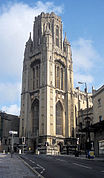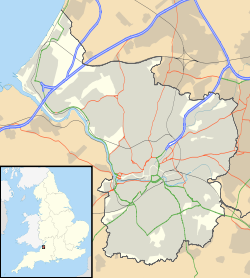- Clifton Hill House
-
Clifton Hill House 
Clifton Hill HouseGeneral information Architectural style Palladian Town or city Bristol Country England Coordinates 51°27′12″N 2°36′48″W / 51.453261°N 2.613260°WCoordinates: 51°27′12″N 2°36′48″W / 51.453261°N 2.613260°W Construction started 1746 Completed 1750 Technical details Size 250 student rooms Design and construction Client Paul Fisher Architect Isaac Ware Clifton Hill House is a grade I listed[1] Palladian villa in the Clifton area of Bristol, England which is now used as a hall of residence by the University of Bristol. The warden is Dr. Thomas Richardson, lecturer in the Department of Aerospace Engineering at the University.
History
The house was built between 1746 and 1750 for the wealthy merchant and philanthropist Paul Fisher, by Isaac Ware, a nationally renowned architect and translator of Palladio's works. Thomas Paty, later a notable Bristol architect, worked as a mason during its construction. The house stands on a steep slope, so that while only three stories face the street, the five-bay garden front is four stories tall with low wings (both raised from one story to two during the nineteenth century) and a double flight of steps down to the garden. Original rococo plasterwork, by Joseph Thomas, survives in a number of interior rooms.[2]
The house was later home to the nineteenth century 'man-of-letters', John Addington Symonds, whose father had bought the house in 1851. The university bought the house from the Symonds family in 1909 to create the first hall of residence for women in south-west England. The university has since bought adjacent property and added modern accommodation blocks to form four areas: Old Clifton, Callander, Fry and South Wings. It houses approximately 230 students.
The Hall has been used by the BBC as a film location for the 'The House of Eliott' and for episodes of 'Casualty'.[3]
Callandar House which dates from the late 18th century is itself grade II listed.[4]
External links
References
- ^ "Clifton Hill House and attached front walls". Images of England. http://www.imagesofengland.org.uk/details/default.aspx?id=379238. Retrieved 2007-03-14.
- ^ Burrough, THB (1970). Bristol. London: Studio Vista. ISBN 0289798043.
- ^ "History of Clifton Hill House". University of Bristol. http://www.cliftonhillhouse.co.uk/history/. Retrieved 2007-03-14.[dead link]
- ^ "Callandar House". Images of England. http://www.imagesofengland.org.uk/details/default.aspx?id=379237. Retrieved 2007-03-14.
- Andrew Foyle (2004). Pevsner Architectural Guides: Bristol. Yale University Press. ISBN 0-300-10442-1.
- Walter Ison (1978). The Georgian Buildings of Bristol. Kingsmead Press. ISBN 0-901571-88-1.
- Andor Gomme (1979). Bristol: an Architectural History. Lund Humphries. ISBN 0-85331-409-8.
- Burnside, Annie, 2009, A Palladian Villa in Bristol: Clifton Hill House and the People who Lived There Bristol University Press
University of Bristol University
University College, Bristol • History • Governance • Academic dress • Alumni • 2003 admissions controversyIndividuals
Chancellor - Brenda Hale, Baroness Hale of Richmond • Vice Chancellor - Eric ThomasDepartments and Buildings
Wills Memorial Building • The Victoria Rooms • Royal Fort House • BLADE • University of Bristol Botanic GardensStudent Life
University of Bristol Union • Student Newspaper • Burst Radio • The TartHalls of residence
Halls of residence at the University of Bristol • Goldney Hall • Clifton Hill House • Wills Hall • Manor HallCategories:
University • Academics • Alumni • Chancellors • Halls • Associated people

This article about a Bristol building or structure is a stub. You can help Wikipedia by expanding it.


